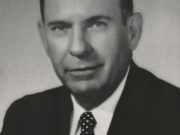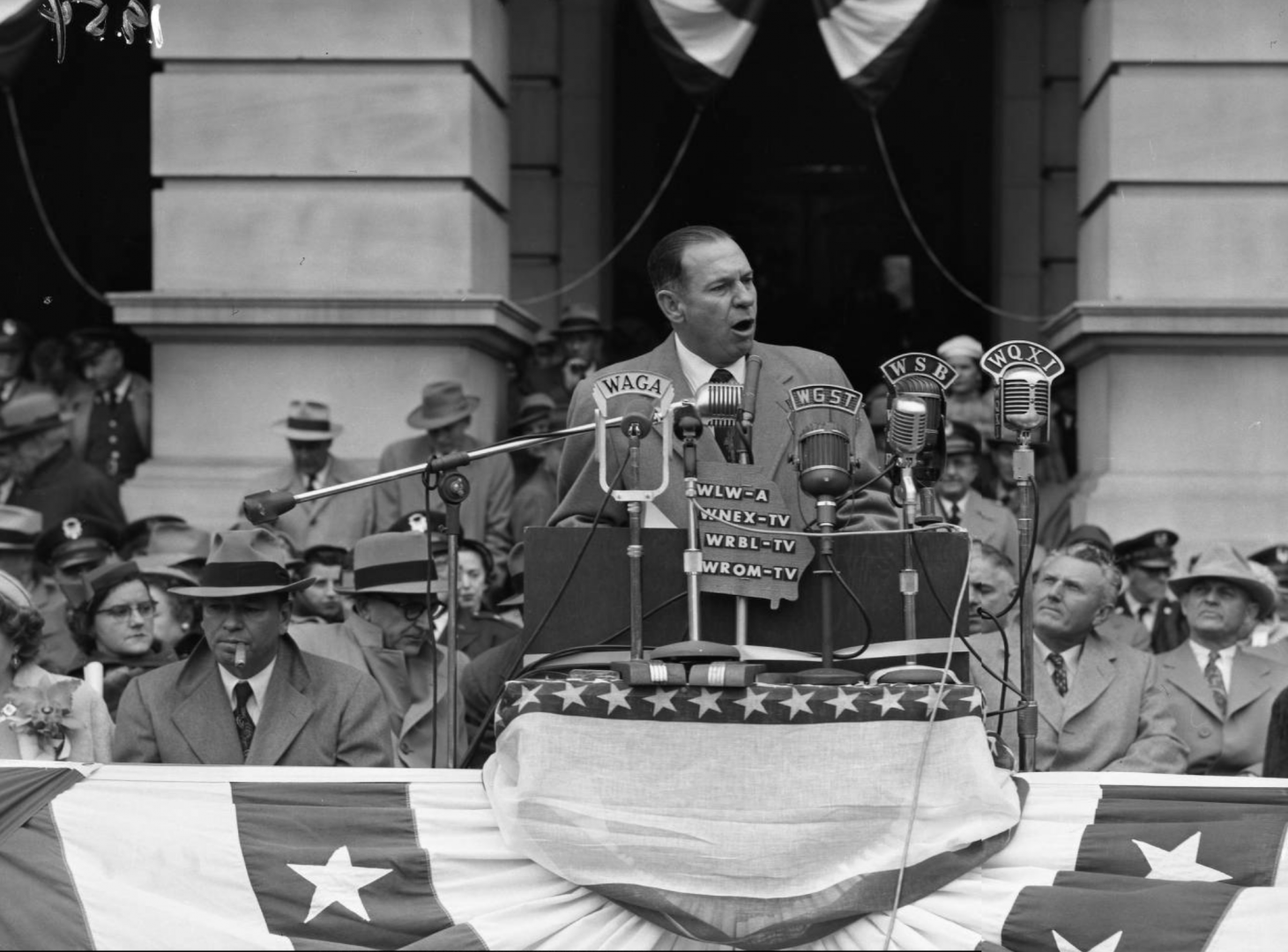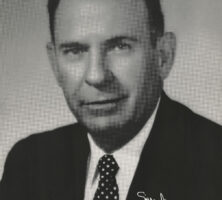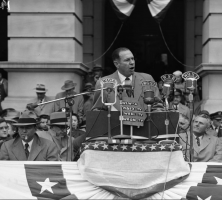Marvin Griffin served as governor of Georgia from 1955 to 1959. Griffin was one of the first governors to serve as a “good will ambassador” to attract industries to Georgia. Griffin, a Democrat, was also a segregationist and promised to close the state’s public school system if federal authorities tried to enforce desegregation. He left office under a cloud of suspicion for corruption in his administration and failed in an attempted gubernatorial comeback in 1962.
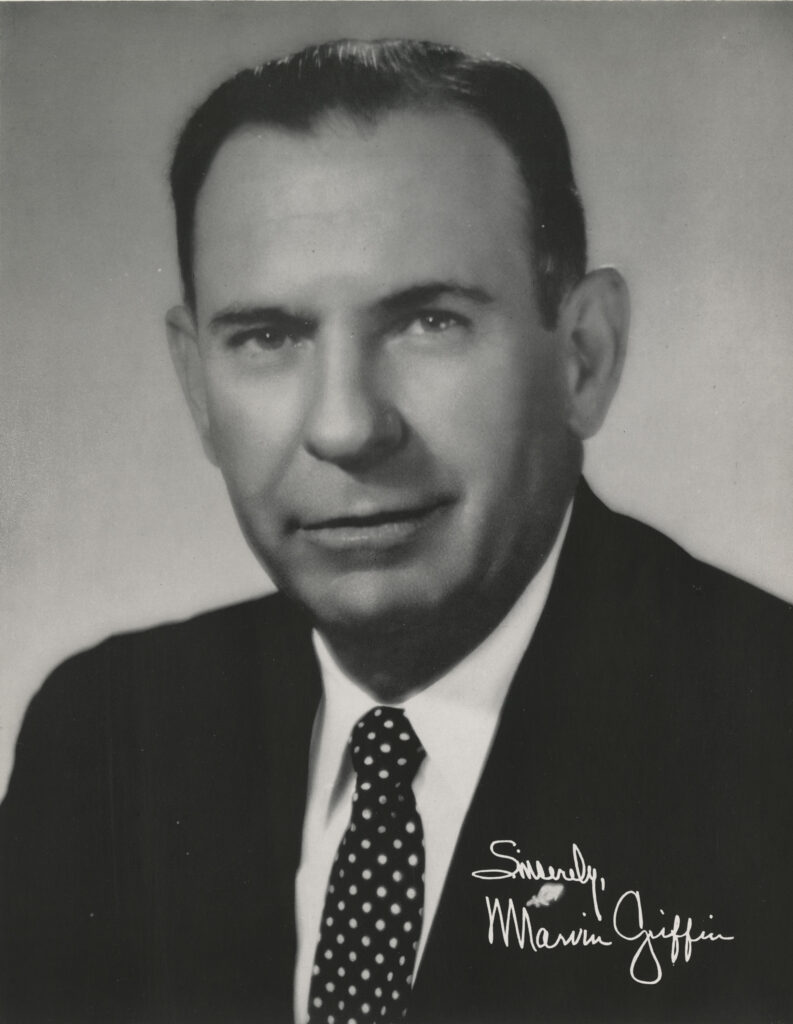
Courtesy of Hargrett Rare Book and Manuscript Library, University of Georgia Libraries.
Early Life
Samuel Marvin Griffin was born September 4, 1907, in Bainbridge. He was the fourth of six children born to Josie Butler and E. H. “Pat” Griffin. In 1929 Griffin graduated from the Citadel in Charleston, South Carolina, and then taught at Randolph-Macon Academy in Front Royal, Virginia. While in Virginia, Griffin met and married Mary Elizabeth “Lib” Smith, and they had two children, Patricia Ann and Samuel Marvin Jr. In 1933, when his father became ill, Griffin moved back to Bainbridge to take over editorship of the family newspaper, the Post-Searchlight.
Griffin became involved in politics when he was elected to the General Assembly in 1934. After losing a bid for the U.S. House of Representatives in 1936, he secured employment in the administration of Governor E. D.
During World War II (1941-45) Griffin enlisted in the army, and he commanded a unit in the South Pacific. He eventually attained the rank of lieutenant colonel. In 1944 Governor Ellis Arnall appointed him adjutant general of the Georgia National Guard, a post he held until 1947. In 1948 Griffin won a special election to fill the executive offices after the “three governors controversy” of 1946, becoming the state’s first lieutenant governor to actually serve in office. Georgia voters overwhelmingly reelected him to that position in 1950.
Gubernatorial Years
In 1954 Griffin ran for governor in a field of nine candidates. Because most Georgians saw Griffin as the chosen candidate of the outgoing governor, Herman Talmadge, he won the election, capturing a majority of the county unit vote. Upon taking office, Griffin reneged on a campaign promise and pushed through an increase in the state income tax, which was needed to offset an expected shortfall in revenues. After the tax increase, the Griffin administration accomplished a great deal for Georgia. The Rural Roads Authority paved nearly 12,000 miles of rural roads in the state. Appropriations for education increased by 50 percent, and teacher salaries rose approximately 25 percent. Griffin oversaw the building of a new science complex at the University of Georgia as well as a nuclear reactor at the Georgia Institute of Technology. The state also purchased Stone Mountain for use as a state park.
Like his contemporaries, Griffin ran for office on a staunch segregationist platform. The U.S. Supreme Court had declared segregation unconstitutional just before the 1954 gubernatorial campaign. In that campaign Griffin promised to protect segregated schools “come hell or high water.” During the Griffin administration no Georgia schools were integrated; the desegregation process did not begin until 1961, two years after he left office. Despite his segregationist rhetoric, Griffin did a great deal to improve education for African Americans. More money was spent on Black schools, and the disparity between Black and white teacher salaries was much reduced. Critics charged that this was an attempt to stave off integration by showing that Black schools were the equal of white schools. Still, there were limits to Griffin’s commitment to racial separation. When pushed by more-ardent segregationists to defy federal court orders on desegregation, Griffin commented that “being in jail kind of crimps a governor’s style.”
Despite Griffin’s accomplishments in office, his administration was marred by charges of corruption. Some members of his administration were found guilty of various crimes, and Griffin’s brother reportedly was involved in illegal activities. A Fulton County grand jury investigated Griffin in 1960 but did not indict him. Still, the corruption allegation would haunt Griffin’s political legacy.
Retirement Years
In 1962 Griffin attempted a comeback by running for governor again. Carl Sanders defeated Griffin, in large part by playing up the corruption issue. This election was the last of the great campaigns in which candidates held large rallies and barbecues. After the election Griffin said, “Everybody that ate my barbecue I don’t believe voted for me.” He retired from active politics, citing ill health—though not his own: “The voters were sick and tired of me.” In 1968 Griffin was temporarily the vice presidential nominee of the American Independent Party when George Wallace ran for president on that ticket, but he never seriously ran for elective office again. In the 1970s Griffin’s beliefs increasingly were in line with those of Republicans, and he openly supported the presidential candidates Gerald Ford and Ronald Reagan. Griffin died of lung cancer on June 13, 1982.


